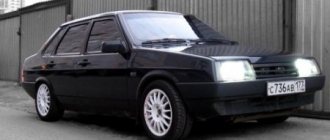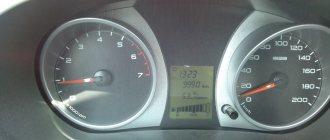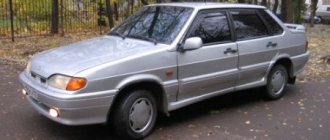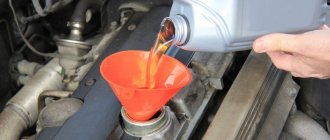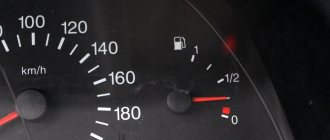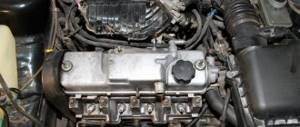Rated fuel consumption is one of the most informative and important characteristics of a car for the driver. This is what manufacturers often use to advertise and promote a particular new car model.
Among owners of used cars, it is considered acceptable to consume up to 10 liters of gasoline or diesel per 100 kilometers. In foreign countries, this indicator is indicated in miles, so recalculation into “native” units is often necessary. The fuel consumption tables available in this section of the site are considered very useful.
What does the fuel consumption indicator indicate? What does this characteristic mean? We are talking about hydrocarbon fuel consumption. For example, for an SUV the figure corresponds to 9.5 liters per 100 km. It is quite acceptable, primarily due to the weight and power of the car. The indicator can be reduced due to the following:
- use of energy recovery systems during braking;
- lightening the weight of the car when replacing body and chassis elements with innovative materials;
- engine improvements;
- replacing the exhaust system.
For new models, consumption of 6 l/100 km is considered quite a “cruising” figure, but it will be higher for heavy SUVs and pickups and lower for small hybrids. The necessary information can be found in the tables provided.
What to do if fuel consumption is higher than rated? If the car consumes more fuel and does not correspond to the nominal value indicated in the table, this means there is a malfunction. Experienced service center technicians will tell you how serious it is and how it can be eliminated. In some cases, tuning makes it possible to further optimize fuel consumption, but this is usually achieved by lightening the body structure or by replacing the engine. Professional automotive technicians can provide specific recommendations.
Fuel consumption of the Lada Priora ranges from 6.6 to 7.6 liters per 100 km.
Lada Priora is available with the following types of fuel: Gasoline AI-95.
Fuel consumption Lada Priora restyling 2013, hatchback 3 doors, 1st generation
| Engine capacity | Power | Transmission | Drive unit | Fuel | Consumption |
| 1.6 l | 106 hp | Manual transmission | front-wheel drive | Gasoline AI-95 | 6,8 |
| 1.6 l | 98 hp | Manual transmission | front-wheel drive | Gasoline AI-95 | 6,9 |
Car color
Some motorists argue that the cost may directly depend on the color of the car. For example, a light model consumes much less than its dark counterpart, but this is far from a guarantee.
American scientists have proven the influence of color. They found that this manifests itself especially in the warm season.
It's a difficult time of year for cars. Priora fuel consumption can vary significantly. The 16 valve Priora consumes more in winter. Firstly, when the engine is not warmed up, the gasoline consumption of the Lada Priora will be higher.
Secondly, the increased complexity of roads that require the car to drift also increases fuel consumption. Thirdly, speed. The slower the car moves, the more gasoline it uses.
Lada Priora, which has 16 valves, is overall more economical than other cars with similar technical characteristics. In addition, if you wish, you can always convert it to gas consumption and significantly save your family budget.
Nowadays, the criterion for the efficiency of a power plant is no less relevant than the number of horsepower or the time it takes to reach the first hundred. The engines of the updated VAZ line, being in good working order, fully meet modern requirements, both in terms of appetite and potential.
Fuel consumption Lada Priora restyling 2013, hatchback 5 doors, 1st generation
| Engine capacity | Power | Transmission | Drive unit | Fuel | Consumption |
| 1.6 l | 106 hp | robot | front-wheel drive | Gasoline AI-95 | 6,6 |
| 1.6 l | 106 hp | Manual transmission | front-wheel drive | Gasoline AI-95 | 6,8 |
| 1.6 l | 98 hp | Manual transmission | front-wheel drive | Gasoline AI-95 | 6,9 |
Fuel consumption Lada Priora restyling 2013, station wagon, 1st generation
| Engine capacity | Power | Transmission | Drive unit | Fuel | Consumption |
| 1.6 l | 106 hp | robot | front-wheel drive | Gasoline AI-95 | 6,6 |
| 1.6 l | 106 hp | Manual transmission | front-wheel drive | Gasoline AI-95 | 6,8 |
| 1.6 l | 98 hp | Manual transmission | front-wheel drive | Gasoline AI-95 | 6,9 |
The impact of tires on fuel consumption
During prolonged cold weather, the car has to be refueled more often, and the same is the case with the Lada Priora. In winter, more fuel is spent because the interior needs to be heated. Maneuvers are also more difficult to perform, which is why experts recommend changing your driving style to a more careful one in winter, because in addition to high fuel consumption, the risk of accidents on the roads increases.
Consumption in the city is affected by how the driver picks up speed and how he/she applies braking. Constant traffic jams also have a negative impact on consumption. Many drivers often turn off the engine in traffic jams, which allows them to save fuel, but this is not always convenient or appropriate, and manufacturers of modern cars have not yet figured out how to effectively save fuel directly in winter. However, if you follow certain recommendations, you can still achieve optimal consumption.
Narrow tires are a source of less resistance, and large ones, on the contrary. Each owner decides on his own what tires to put on his LADA Priora. But it is worth remembering what recommendations the manufacturer gives. And many experienced car owners will tell you that tires do not greatly affect fuel consumption.
Fuel consumption Lada Priora restyling 2013, sedan, 1st generation
| Engine capacity | Power | Transmission | Drive unit | Fuel | Consumption |
| 1.6 l | 106 hp | robot | front-wheel drive | Gasoline AI-95 | 6,6 |
| 1.6 l | 106 hp | Manual transmission | front-wheel drive | Gasoline AI-95 | 6,8 |
| 1.6 l | 98 hp | Manual transmission | front-wheel drive | Gasoline AI-95 | 6,9 |
| 1.6 l | 87 hp | Manual transmission | front-wheel drive | Gasoline AI-95 | 7,3 |
Fuel consumption Lada Priora 2010, hatchback 3 doors, 1st generation
| Engine capacity | Power | Transmission | Drive unit | Fuel | Consumption |
| 1.6 l | 98 hp | Manual transmission | front-wheel drive | Gasoline AI-95 | 6,9 |
| 1.6 l | 98 hp | Manual transmission | front-wheel drive | Gasoline AI-95 | 7,4 |
Why is the color of a car so important?
As it turns out, the color of your car affects your fuel consumption per 100 km. Research has been conducted on this topic in the USA. As it turned out, cars with white, silver, and generally light colors heat up less in hot weather. Consequently, less energy is spent on cooling the interior, which allows for 1.
If you just purchased a LADA Priora, then in all likelihood the luggage compartment is almost empty, but a couple of months will pass and various things will appear there, useful and sometimes not so useful. Also, the car can carry any loads, and how they are distributed determines what the fuel consumption will be per 100 km.
As an example, consider a racing car. It necessarily calculates the center of gravity of the pilot's seat structure. Naturally, all calculations are carried out so that the car can develop more speed, but this also helps to save fuel. Therefore, if you remove everything heavy and unnecessary from the trunk of a Priora, you can replace it and reduce consumption.
Here's another example, you put a heavy bag (several bags) in the right side of the luggage compartment, and this causes serious stress on the right spring. It will be optimal if you place the bags in the center. It was found that the fuel consumption of a car increases by 1 liter for every 100 km of travel if there is an additional load weighing 100 kg. So consider it.
Fuel consumption Lada Priora 2008, hatchback 5 doors, 1st generation
| Engine capacity | Power | Transmission | Drive unit | Fuel | Consumption |
| 1.6 l | 98 hp | Manual transmission | front-wheel drive | Gasoline AI-95 | 7,2 |
| 1.6 l | 87 hp | Manual transmission | front-wheel drive | Gasoline AI-95 | 7,3 |
| 1.6 l | 81 hp | Manual transmission | front-wheel drive | Gasoline AI-95 | 7,6 |
Fuel consumption Lada Priora 2007, sedan, 1st generation
| Engine capacity | Power | Transmission | Drive unit | Fuel | Consumption |
| 1.6 l | 98 hp | Manual transmission | front-wheel drive | Gasoline AI-95 | 7,2 |
| 1.6 l | 87 hp | Manual transmission | front-wheel drive | Gasoline AI-95 | 7,3 |
| 1.6 l | 80 hp | Manual transmission | front-wheel drive | Gasoline AI-95 | 7,6 |
Increased fuel consumption on Lada Priora: why?
5: Sensors inspected and replaced
This makes many sigh, but it remains an aspect of service that we don't check on often enough. And if you live in the dusty, dry southwest, air filters should be checked often when you check your tire pressure. Electronic engine control sensors are the nerve endings of the fuel injection and ignition systems. Without them, your computer's hardware cannot do its job properly, if it can be done at all. Gauges include coolant temperature, intake air temperature, mass air flow, throttle position, oxygen, crank trigger, cam triggers, EGR, manifold air pressure, evaporative canister cleaning, and automatic transmission.
- throttle position sensor (TPS), mounted in the throttle body;
- coolant temperature meter installed in the cylinder block housing;
- oxygen sensor (lambda probe), located in the exhaust manifold housing;
- mass air flow sensor (MAF), mounted in the pipe supplying air to the throttle;
- Idle air regulator (IAC), mounted in the throttle assembly.
Faults of this kind are diagnosed using special hardware and eliminated by replacing sensors with known good ones. Installing a new sensor with an incorrect code may cause an increase in “appetite”.
Each of these sensors provides electronic engine control input to ensure proper engine operation. Follow the manufacturer's recommendations. There are endless discussions regarding cleaning and replacing the fuel injector. Indeed, fuel injectors can last forever. Even the most neglected fuel injectors still perform courageously because fuel injectors are largely self-cleaning. They rotate as they open and close, which cleans the needle and seat.
And if your automaker doesn't offer injector cleaning, forget about it. If you own an older collector car, especially one of the classic muscle cars, and want improved fuel economy for extended cruising, consider installing overdrive. These are hidden overdrive systems that you can install in a classic car and no one will know it's there but you. When you overdrive, your car will gulp fuel instead of gulping it. Some car enthusiasts regularly visit dyno shops for live dyno work in search of strength.
However, other reasons may also contribute to the increase in fuel consumption on a Priora with a 16-valve engine:
- low and unstable pressure in the fuel system, indicating clogged injectors, low fuel pump life, clogged filters in the system;
- clogged catalyst, causing the preparation of an enriched mixture;
- a dirty air filter, which not only disrupts the operation of the mass air flow sensor, simultaneously reducing its service life, but also provokes the occurrence of the phenomenon of “air starvation”;
- cold or constantly overheating engine (especially important when the thermostat is not working).
Often the consumption increases due to incorrect operation of the adsorber purge valve. The situation returns to “normal” after replacing the defective unit with a known good one.
But did you know that custom dynos can also improve fuel economy? The key is to communicate what you want from the dynamo tune. By recalibrating the fuel and spark curves, fuel economy can improve along with power. Make sure the work is done correctly and that it does not void your manufacturer's warranty.
Fuel consumption may increase due to air leaks in the power system. Often the place of “unwanted recharge” is the fittings located on the back side of the sound-insulating plastic motor casing with the inscription “16 VALVE”. By placing plugs on the brake cylinder bleeder fittings on the components in question, you can prevent air leaks.
This will negatively affect fuel economy. Your vehicle's evaporative emission control system has an indirect effect on engine performance and fuel economy. The evaporative emissions system consists of vacuum hoses, a charcoal canister, and purge solenoids. Evaporative emissions work by trapping fuel vapors in the tank and directing them to the engine being burned. With time and use, the hoses become dry and rotted, the canister becomes dirty, and the purge solenoids may stop bleeding.
